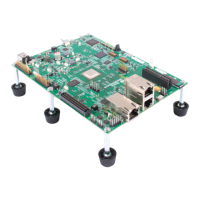Power Management
4-56
4.6.6 Using Sleep Modes
PWRM allows applications to activate sleep modes, which place the DSP in
a low-power state. Implementations of sleep modes vary across target
platforms, and can include idling clocks, reducing operating voltage, and
powering off subsystems. Currently, two sleep modes are supported for the
’C5509A: deep sleep and sleep until restart.
❏ Deep sleep allows the DSP to enter a minimum power state while waiting
for an external interrupt. When the interrupt occurs, the DSP gracefully
and quickly resumes processing where it left off. By default, all clock
domains are idled in deep sleep, but PWRM allows you to override this
and configure the specific clock domains to be idled during deep sleep.
❏ Sleep until restart is a more drastic mode. The DSP is put into a minimal
power state with no intention of resuming until the DSP is rebooted.
The PWRM module also supports coordination of sleep state changes across
the application, through a registration and notification mechanism. For
example, a driver that controls an external codec can register to be notified
when the DSP is going to deep sleep, so that it can tell the external device to
go to a low power state. When the DSP wakes from deep sleep, the driver
again gets notified, and sends the appropriate command to wake the codec.
4.6.7 Coordinating Sleep and Scaling
PWRM allows code that cares about power events to be registered for
notification when specific power events occur. Similarly, code can be un-
registered when it no longer needs notification.
Clients can call PWRM_registerNotify to register to be notified about the
following types of events:
❏ Power events:
■ The V/F setpoint is about to change.
■ The pending V/F setpoint change has now been made.
❏ Sleep events:
■ The DSP is going to deep sleep.
■ The DSP has awoken from deep sleep.
■ The DSP is going to deep sleep and must be restarted to resume.
Figure 4-13 shows a sequence in which clients register and get notified of V/F
power scaling events.
